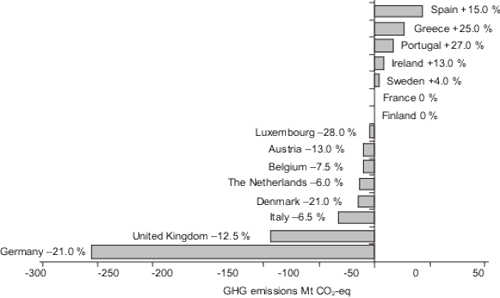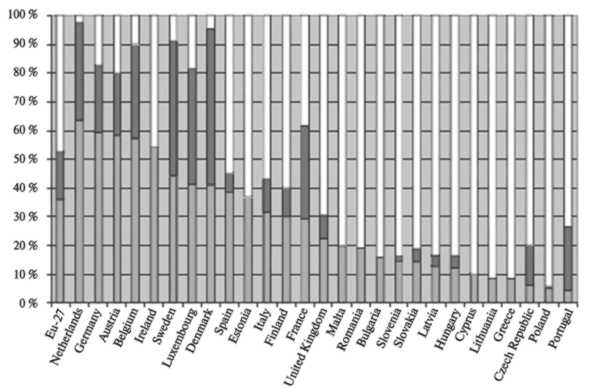
Главная
страница
Сведения об авторах
WASTE SECTORS CONTRIBUTION TO REDUCING GREENHOUSE GAS EMISSIONS
Sieck M., Federal Environment Agency, Dessau, Germany
Germany has undertaken to make a 21 % reduction in greenhouse gas emissions by 2012 compared with 1990 (Kyoto target under the EU burden-sharing). This is about 256 million tonnes CO2-equivalents and means about 70 % of the reduction target of the European Union (EU 15) (Fig. 1).

Fig. 1. Greenhouse gas emission targets of EU Member States for 2008–2012
relative to base-year emissions under the EU burden-sharing decision
Approximately 20 % of reduction was achieved by 2005, and the waste sector made a major contribution to this by avoiding methane emissions due to landfill.
Methane is produced over a period of many years by anaerobic degradation of the organic components in municipal waste. Its global warming potential is 21 times more powerful than carbon dioxide.
The total sum of municipal waste (domestic and bulky waste, and waste for recycling as a subset of municipal waste) has remained constant over the years in Germany. With economic growth at 15 % (1992–2001), this suggests a severing of the link between waste quantity and economic growth which is one important goal of the Sixth Environment Action Programme of the European Union.
Within the overall quantity, there are furthermore
signs of a significant shift in waste quantities, away from disposal in favour
of the separate collection and recovery of such waste. The environmental goal of
the waste management sector is to promote closed substance cycles in the
interest of conserving natural resources and ensuring environmentally sound
waste disposal.
Disregarding the sorting and treatment residues of separately collected waste
for recycling, this translates into an increase in the material recycling ratio
from 12 % in 1990 to more than 46 % in 2001.
If the recycling of domestic and bulky waste is also included, overall, a material and energy recovery ratio of 53 % of waste from households was achieved in 2001.
Emissions of climate relevant gases were significantly reduced. Following the entry into force of the Waste Management and Product Recycling Act in 1996, the practice of depositing untreated organic waste as landfill was gradually abandoned.
In June 2005 the German Ordinance on Environmentally Compatible Storage of Waste from Human Settlements was implemented in full which means that no untreated waste is allowed to go to landfill anymore.
The most important impact on climate change is the avoided methane emitted from landfills. But also the energy recovery e. g. from Waste-to-energy plants avoids carbon dioxide emissions by substituting fossil fuels.
Half of the produced energy is regarded as renewable
because it derives from the biodegradable part of waste.
Actual research studies show that between 1990 and 2005 about 46 Mio t CO2-equivalents
have been avoided by the waste management sector.
Further potential is available in Germany but especially in the European Union if all member states restrain from landfilling of untreated waste and move to a recycling and energy recovery society.
Historically, disposal by landfilling has been the
predominant treatment method for municipal waste. Over the last two decades
considerable reductions in landfilling have taken place, but as shown in Fig. 2
there are significant differences between EU Member States.

Fig. 2. Management of municipal waste in the EU-27 in 2004:
![]()
Countries like Denmark and the Netherlands have high recycling rates and a high
amount of waste that is incinerated. So only 2–3 % of municipal waste goes to
landfill.
On the other hand there are some countries where landfilling is still the predominant method.
The EU Landfill Directive sets targets for diverting biodegradable waste from landfills. The Directive requires landfill quantities of biodegradable material to be reduced to 75 % of the 1995 figure by 2006, to 50 % by 2009 and to 35 % by 2016. Some member states have already reached the target of 2016 and others have still a long way to go to reach these targets. The implementation of the Directive means also that all new landfill sites must have gas recovery facilities and that such facilities will need to be installed in all existing landfill sites by 2009. The achievement of these goals implies further reductions in methane emissions.
Concerning the necessary additional incineration plants there is one important consideration: They should be built in accordance with the latest technology (BREF 2005) to ensure that the energy output potential is fully exploited and that success in reducing CO2 emissions is not bought at the cost of additional burdens of airborne pollutants.
Contribution of biowaste recovery. Separate collection and recovery of biowaste in modern closed systems plays an outstanding role, because it is one of the waste management paths that made the departure from landfill possible in the first place. Through material and energy recovery from biogenic residual waste, this path makes a contribution to reducing climate-relevant gases by avoiding methane emissions. It is also possible to replace fossil fuels if the waste is fermented, thereby producing biogas. For this purpose fermentation systems would have to replace the aerobic composting that is standard practice today.
The biogas can be used to power efficient gas generators in CHP plants. Fermentation plants as a closed system also have the advantage that they minimise emissions of nitrous oxide, which is particularly climate relevant (global warming potential 310 times more powerful than CO2).
In Germany the economic foundation for changing over to fermentation has been
laid by the Renewable Energies Act. It is fixing a system of feed in tariffs for
electricity from Renewable Energy Sources (RES) which obliges the energy
suppliers to buy electricity from RES for a fixed price per kWh, valid for the
twenty years following the grid access of a RES e plant. To avoid a permanent
grant effect the feed in tariffs are decreasing for most of RES every year
between 1.5 % and 5 %.
Sieck Marlene, Federal Environment Agency, Worlitzer Platz 1, Dessau, 06844, Germany. Tel. (340) 2103-24-64. E-mail
© Независимое агентство экологической информации
Последние изменения внесены 23.08.08